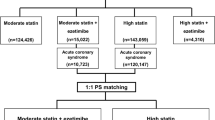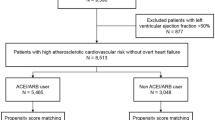Abstract
We assessed the ‘synergy’ of statins and angiotensin-converting enzyme inhibitors (ACEI) in reducing vascular events in patients with coronary heart disease (CHD). The GREek Atorvastatin and CHD Evaluation (GREACE) Study, suggested that aggressive reduction of low density lipoprotein cholesterol to 2.59 mmol/l (<100 mg/dl) significantly reduces morbidity and mortality in CHD patients, in comparison to undertreated patients. In this post hoc analysis of GREACE the patients (n=1600) were divided into four groups according to long-term treatment: Group A (n=460 statin+ACEI), B (n=420; statin, no ACEI), C (n=371;no statin, on ACEI), and D (n=349; no statin, no ACEI). Analysis of variance was used to assess differences in the relative risk reduction (RRR) in ‘all events’ (primary end point) between groups. During the 3-year follow-up there were 292 cardiovascular events; 45 (10% of patients) in group A, 61 (14.5%) in group B, 91 in group C (24.5%) and 95 events in group D (27%). The RRR (95% confidence interval (CI) in the primary end point in group A was 31%, (95% CI −48 to −6%, P=0.01) in comparison to group B, 59% (95% CI −72 to −48%, P<0.0001) to group C and 63% (95% CI −74 to −51%, P<0.0001) to group D. There was no significant difference in RRR between groups C and D (9%, CI −27–10%, P=0.1). Other factors (eg the blood pressure) that can influence clinical outcome did not differ significantly between the four treatment groups. In conclusion, the statin+ACEI combination reduces cardiovascular events more than a statin alone and considerably more than an ACEI alone. Aggressive statin use in the absence of an ACEI also substantially reduced cardiovascular events. Treatment with an ACEI in the absence of a statin use reduced clinical events in comparison to patients not treated with an ACEI but not significantly, at least in these small groups of patients.
This is a preview of subscription content, access via your institution
Access options
Subscribe to this journal
Receive 12 digital issues and online access to articles
$119.00 per year
only $9.92 per issue
Buy this article
- Purchase on Springer Link
- Instant access to full article PDF
Prices may be subject to local taxes which are calculated during checkout
Similar content being viewed by others
References
Scandinavian Simvastatin Survival Study (4S) Group. Randomized trial of cholesterol lowering in 4444 patients with coronary heart disease. Lancet 1994; 344: 1383–1389.
Sacks FM, et al, for the Cholesterol and Recurrent Events Trial Investigators. The effect of pravastatin on coronary events after myocardial infarction in patients with average cholesterol levels. N Engl J Med 1996; 335: 1001–1009.
Long-term Intervention with Pravastatin Ischaemic Disease (LIPID) Study Group. Prevention of cardiovascular events and death with pravastatin in patients with coronary heart disease and a broad range of initial cholesterol levels. N Engl J Med 1998; 339: 1349–1357.
Heart Protection Study Collaborative Group. MRC/BHF Heart Protection Study of cholesterol lowering with simvastatin in 20536 high-risk individuals: a randomized placebo-controlled trial. Lancet 2002; 360: 7–22.
Fox KM, and The EURopean trial On reduction of cardiac events with Perindopril in stable coronary Artery disease Investigators. Efficacy of perindopril in reduction of cardiovascular events among patients with stable coronary artery disease: randomised, double-blind, placebo-controlled, multicentre trial (the EUROPA study). Lancet 2003; 362: 782–788.
Athyros VG et al. Treatment with atorvastatin to the National Cholesterol Educational Program goals versus usual care in secondary Coronary Heart Disease prevention: the GREek Atorvastatin and Coronary-heart-disease Evaluation (GREACE) Study. Curr Med Res Opin 2002; 18: 220–228.
Athyros VG et al. Early benefit from structured care with atorvastatin in patients with coronary heart disease and diabetes mellitus: a subgroup analysis of the GREek Atorvastatin and Coronary-heart-disease Evaluation (GREACE) Study. Angiology 2003; 54: 679–690.
Athyros VG et al. The effect of statins versus untreated dyslipidaemia on renal function in patients with coronary heart disease: a subgroup analysis of the GREek Atorvastatin and Coronary-heart-disease Evaluation (GREACE) Study. J Clin Pathol 2004 (in press).
Athyros VG et al. The effect of statins versus untreated dyslipidaemia on serum uric acid levels in patients with coronary heart disease: a subgroup analysis of the GREek Atorvastatin and Coronary-heart-disease Evaluation (GREACE) Study. Am J Kidney Dis 2004; 43: 589–599.
Executive Summary of The Third Report of The National Cholesterol Education Program (NCEP). Expert Panel on detection, evaluation, and treatment of high blood cholesterol in adults (Adult Treatment Panel III). JAMA 2001; 285: 2486–2497.
Cockroft DW, Gault MH . Prediction of creatinine clearance from serum creatinine. Nephron 1976; 16: 31–41.
Kaplan RC, Heckbert SR, Furberg CD, Psaty BM . Predictors of subsequent coronary events, stroke, and death among survivors of first hospitalized myocardial infarction. J Clin Epidemiol 2002; 55: 654–664.
Bickel C et al. Serum uric acid as an independent predictor of mortality in patients with angiographically proven coronary artery disease. Am J Cardiol 2002; 89: 12–17.
Fang J, Alderman MH . Serum uric acid and cardiovascular mortality the NHANES I epidemiologic follow-up study, 1971–1992. National Health and Nutrition Examination Survey. JAMA 2000; 283: 2404–2410.
Elisaf M, Mikhailidis DP . Statins and renal function. Angiology 2002; 53: 493–502.
Youssef F et al. The early effect of lipid-lowering treatment on carotid and femoral intima media thickness (IMT). Eur J Vasc Endovasc Surg 2002; 23: 358–364.
Youssef F et al. The effect of short-term treatment with simvastatin on renal function in patients with peripheral arterial disease. Angiology 2004; 55: 53–62.
Sinzinger H, Kritz H, Furberg CD . Atorvastatin reduces microalbuminuria in patients with familial hypercholesterolemia and normal glucose tolerance. Med Sci Monit 2003; 9: 88–92.
Heart Protection Study Collaborative Group . MRC/BHF Heart Protection Study of cholesterol-lowering with simvastatin in 5963 people with diabetes: a randomised placebo-controlled trial. Lancet 2003; 361: 2005–2016.
Lonn EM et al. Emerging role of angiotensin-converting enzyme inhibitors in cardiac and vascular protection. Circulation 1994; 90: 2056–2069.
Dzau VJ . Mechanism of protective effects of ACE inhibition on coronary artery disease. Eur Heart J 1998; 19(Suppl J): J2–J6.
Yusuf S et al. Effect of enalapril on myocardial infarction and unstable angina in patients with low ejection fractions. Lancet 1992; 340: 1173–1178.
Pfeffer MA et al; The SAVE Investigators. Effect of captopril on mortality and morbidity in patients with left ventricular dysfunction after myocardial infarction. N Engl J Med 1992; 327: 669–677.
The Heart Outcomes Prevention Evaluation Study (HOPE) Investigators. Effects of an angiotensin-converting enzyme inhibitor, ramipril, on cardiovascular events in high-risk patients. N Engl J Med 2000; 342: 145–153.
Kober L et al. A clinical trial of the angiotensin-converting-enzyme inhibitor trandolapril in patients with left ventricular dysfunction after myocardial infarction. Trandolapril Cardiac Evaluation (TRACE) Study Group. N Engl J Med 1995; 333: 1670–1676.
Mancini GB et al. Angiotensin-converting enzyme inhibition with quinapril improves endothelial vasomotor dysfunction in patients with coronary artery disease. The TREND (Trial on Reversing ENdothelial Dysfunction) Study. Circulation 1996; 94: 258–265.
PROGRESS Collaborative Group. Randomised trial of a perindopril-based blood-pressure-lowering regimen among 6,105 individuals with previous stroke or transient ischaemic attack. Lancet 2001; 358: 1033–1041.
Teo KK et al. Long-term effects of cholesterol lowering and angiotensin-converting enzyme inhibition on coronary atherosclerosis: the Simvastatin/Enalapril Coronary Atherosclerosis Trial (SCAT). Circulation 2000; 102: 1748–1754.
Schoenhagen P, White RD, Nissen SE, Tuzcu EM . Coronary imaging: angiography shows the stenosis, but IVUS, CT, and MRI show the plaque. Cleve Clin J Med 2003; 70: 713–719.
Esper RJ et al. Endothelium-dependent responses in patients with hypercholesterolemic coronary artery disease under the effects of simvastatin and enalapril, either separately or combined. Am Heart J 2000; 140: 684–689.
Gryglewski RJ et al. Comparison of endothelial pleiotropic actions of angiotensin converting enzyme inhibitors and statins. Ann N Y Acad Sci 2001; 947: 229–245.
Nazzaro P et al. Distinct and combined vascular effects of ACE blockade and HMG-CoA reductase inhibition in hypertensive subjects. Hypertension 1999; 33: 719–725.
Papadakis JA et al. Effect of hypertension, and its treatment, on lipid, lipoprotein (a), fibrinogen and bilirubin levels in patients referred for dyslipidaemia. Am J Hypertens 1999; 12: 673–681.
Milionis HJ, Elisaf MS, Mikhailidis DP . The effects of lipid-regulating therapy on haemostatic parameters. Curr Pharm Des 2003; 9: 2425–2443.
Tsiara S, Elisaf M, Mikhailidis DP . Early vascular benefits of statin therapy. Curr Med Res Opin 2003; 19: 540–556.
Ganotakis ES, Papadakis JA, Vrentzos GE, Mikhailidis DP . The effects of antihypertensive therapy on haemostatic parameters. Curr Pharm Des 2003; 9: 2445–2464.
Virdis A et al. Presence of cardiovascular structural changes in essential hypertensive patients with coronary microvascular disease and effects of long-term therapy. Am J Hypertens 1996; 9: 361–369.
Novo S, Abrignani MG, Corda M, Strano A . Cardiovascular structural changes in hypertension: possible regression during long-term antihypertensive treatment. Eur Heart J 1991; 12(Suppl G): 47G–53G.
Eichstadt HW et al. Improvement of myocardial perfusion by short-term fluvastatin therapy in coronary artery disease. Am J Cardiol 1995; 76(Suppl A): 122A–125A.
Cheng KS, Mikhailidis DP, Hamilton G, Seifalian AM . A review of the carotid and femoral intima-media thickness as an indicator of the presence of peripheral vascular disease and cardiovascular risk factors. Cardiovasc Res 2002; 54: 528–538.
Kontopoulos AG, Athyros VG, Papageorgiou AA, Boudoulas H . Effect of quinapril or metoprolol on circadian sympathetic and parasympathetic modulation after acute myocardial infarction. Am J Cardiol 1999; 84: 1164–1169.
Pehlivanidis AN et al. Heart rate variability after long-term treatment with atorvastatin in hypercholesterolaemic patients with or without coronary artery disease. Atherosclerosis 2001; 157: 463–469.
Kontopoulos AG et al. Long-term treatment effect of atorvastatin on aortic stiffness in hypercholesterolaemic patients. Curr Med Res Opin 2003; 19: 22–27.
Mitchell LB et al; AVID Investigators. Are lipid-lowering drugs also antiarrhythmic drugs? An analysis of the Antiarrhythmics versus Implantable Defibrillators (AVID) trial. J Am Coll Cardiol 2003; 42: 81–87.
Quintana M et al. Heart rate variability as a means of assessing prognosis after acute myocardial infarction. Eur Heart J 1997; 18: 789–797.
van Boven AJ et al. Depressed heart rate variability is associated with events in patients with stable coronary artery disease and preserved left ventricular function. REGRESS Study Group. Am Heart J 1998; 135: 571–576.
Stefanadis C et al. Aortic stiffness as a risk factor for recurrent acute coronary events in patients with ischaemic heart disease. Eur Heart J 2000; 21: 390–396.
Benetos A et al. Pulse pressure: a predictor of long-term cardiovascular mortality in a French male population. Hypertension 1997; 30: 1410–1415.
Author information
Authors and Affiliations
Consortia
Corresponding author
Rights and permissions
About this article
Cite this article
Athyros, V., Mikhailidis, D., Papageorgiou, A. et al. Effect of statins and ACE inhibitors alone and in combination on clinical outcome in patients with coronary heart disease. J Hum Hypertens 18, 781–788 (2004). https://doi.org/10.1038/sj.jhh.1001748
Received:
Revised:
Accepted:
Published:
Issue Date:
DOI: https://doi.org/10.1038/sj.jhh.1001748
Keywords
This article is cited by
-
The Effects of a Perindopril-Based Regimen in Relation to Statin Use on the Outcomes of Patients with Vascular Disease: a Combined Analysis of the ADVANCE, EUROPA, and PROGRESS Trials
Cardiovascular Drugs and Therapy (2024)
-
Safety and efficacy of a cardiovascular polypill in people at high and very high risk without a previous cardiovascular event: the international VULCANO randomised clinical trial
BMC Cardiovascular Disorders (2022)
-
Beneficial effect of ACE inhibitors on kidney function in polycythemia vera
Wiener klinische Wochenschrift (2021)
-
Triple Combination Therapy for Global Cardiovascular Risk: Atorvastatin, Perindopril, and Amlodipine
American Journal of Cardiovascular Drugs (2016)
-
Hypercholesterolemia and Hypertension: Two Sides of the Same Coin
American Journal of Cardiovascular Drugs (2015)



